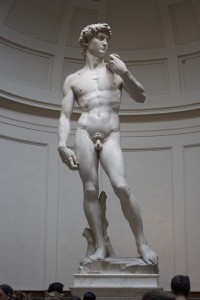Recently revisiting the Michelangelo’s David at the Academia Gallery in Florence reminded us both of the differencing mindset and approach a stone carver has to sculpt a figurative piece, to that of a clay modeller. Most people understand the concept of carving as a process of working from the outside inwards to determine the figure, which is the complete reversal to the clay modelling process. Both being clay modeller’s our appreciation of the carving process is naturally heightened when admiring the work of Michelangelo.
Interestingly, Michelangelo always kept his working methods a secret, however his friend and biographer Giorgio Vasari does write an account on Michelangelo’s working methods and practices. Vasari’s description of the process does seem to contradict though, particularly when scrutinising Michelangelo’s unfinished works for example the Slaves, “Awakening Slave”, “Young Slave”, “Atlas Slave”, & “Bearded Slave”. (all four in the Academia). Vasari seems to describe generic and commonplace practices that stone carvers would follow. For example, previously making clay terracotta models of the subject prior to carving, then often as not, casting these into wax to be used for reference only. The Water Box system, although, Michelangelo apparently did not use this or the Pointillism system, these were very traditional methods of orientating the reference points of the figure within the stone block. It seems Michelangelo worked directly into the stone, having one main primary viewpoint, as can be seen in the unfinished Slaves.
It is worth remembering that a copy of Michelangelo’s David does exist in the Victoria and Albert Museum in the plaster casts room.
